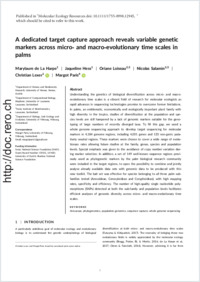A dedicated target capture approach reveals variable genetic markers across micro- and macro-evolutionary time scales in palms
- Harpe, Marylaure de La Department of Botany and Biodiversity Research, University of Vienna, Austria
- Hess, Jaqueline Department of Botany and Biodiversity Research, University of Vienna, Austria
- Loiseau, Oriane Department of Computational Biology, University of Lausanne, Switzerland - Swiss Institute of Bioinformatics, Lausanne, Switzerland
- Salamin, Nicolas Department of Computational Biology, University of Lausanne, Switzerland - Swiss Institute of Bioinformatics, Lausanne, Switzerland
- Lexer, Christian Department of Botany and Biodiversity Research, University of Vienna, Austria
- Paris, Margot Department of Biology, Unit Ecology and Evolution, University of Fribourg, Switzerland
-
2019
Published in:
- Molecular Ecology Resources. - 2019, vol. 19, no. 1, p. 221-234
English
Understanding the genetics of biological diversification across micro‐ and macro‐ evolutionary time scales is a vibrant field of research for molecular ecologists as rapid advances in sequencing technologies promise to overcome former limitations. In palms, an emblematic, economically and ecologically important plant family with high diversity in the tropics, studies of diversification at the population and species levels are still hampered by a lack of genomic markers suitable for the genotyping of large numbers of recently diverged taxa. To fill this gap, we used a whole genome sequencing approach to develop target sequencing for molecular markers in 4,184 genome regions, including 4,051 genes and 133 non‐genic putatively neutral regions. These markers were chosen to cover a wide range of evolutionary rates allowing future studies at the family, genus, species and population levels. Special emphasis was given to the avoidance of copy number variation during marker selection. In addition, a set of 149 well‐known sequence regions previously used as phylogenetic markers by the palm biological research community were included in the target regions, to open the possibility to combine and jointly analyse already available data sets with genomic data to be produced with this new toolkit. The bait set was effective for species belonging to all three palm sub‐families tested (Arecoideae, Ceroxyloideae and Coryphoideae), with high mapping rates, specificity and efficiency. The number of high‐quality single nucleotide polymorphisms (SNPs) detected at both the sub‐family and population levels facilitates efficient analyses of genomic diversity across micro‐ and macro‐evolutionary time scales.
- Faculty
- Faculté des sciences et de médecine
- Department
- Département de Biologie
- Language
-
- English
- Classification
- Biological sciences
- License
-
License undefined
- Identifiers
-
- RERO DOC 323899
- DOI 10.1111/1755-0998.12945
- Persistent URL
- https://folia.unifr.ch/unifr/documents/307565
Other files
Statistics
Document views: 126
File downloads:
- pdf: 1243
- Supplementary material (Tab1): 46
- Supplementary material (Tab 2): 57
- Supplementary material (Tab 3): 58

